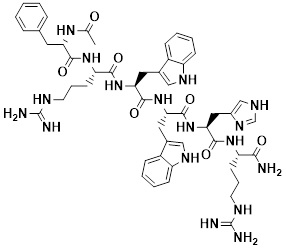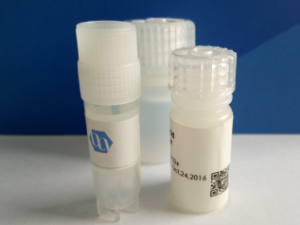$ 360.0
Quantity: 100mg
In stock
Description
Product name: Combi-2
Catalog#: 1399035
Synonyms: Ac-FRWWHR-NH2
Sequence: Ac-Phe-Arg-Trp-Trp-His-Arg-NH2
Modifications: N-terminal acetylation,C-terminal amide,
M.W: 1028.19
M.F.: C51H65N17O7
Purity: 95%
Counter ion: Trifluoacetate
Format: Lyophilized powder
Description: The acetylated and amidated hexapeptide FRWWHR (combi-2), previously identified by combinatorial chemistry methods, shows strong antimicrobial activity. The binding of the peptide to 1-palmitoyl-2-oleoyl-sn-glycero-3-[(phospho-rac-(1-glycerol)] (POPG) and 1-palmitoyl-2-oleoyl-sn-glycero-3-phosphocholine (POPC) vesicles was studied using fluorescence spectroscopy and isothermal titration calorimetry (ITC). Differential scanning calorimetry (DSC) with dipalmitoylphosphatidylcholine (DPPC) and dipalmitoylphosphatidylglycerol (DPPG) multilamellar vesicles was performed to determine changes in the lipid phase behaviour upon binding the peptide. Two-dimensional proton nuclear magnetic resonance (NMR) spectroscopy, to solve the bound peptide structure, was performed in the presence of dodecylphosphatidylcholine (DPC) and sodium dodecyl sulphate (SDS) micelles. The fluorescence, ITC and DSC studies indicate that the peptide interacts preferentially with lipid vesicles containing negatively charged head groups. Conformational information determined using NMR indicate that the combi-2 peptide adopts a coiled amphipathic conformation when bound to SDS and DPC micelles. Leakage assays indicate that the peptide is not very efficient at causing leakage from calcein-filled large unilamellar vesicles comprised of POPG/POPC (1 : 1). The rapid passage of either the fluorescent-tagged peptides combi-2 or the previously studied peptide Ac-RRWWRF-NH(2) (combi-1) into Escherichia coli and Staphylococcus aureus suggests that instead of membrane disruption, the main bactericidal site of action of these peptides might be located inside bacteria.
Usage: For Scientific Research Use Only, Not for Human Use.


